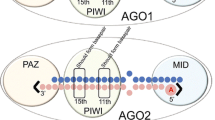Abstract
It remains unclear how post-transcriptional gene silencing (PTGS) in plants discriminates aberrant RNAs from canonical messenger RNAs (mRNAs). The key step of plant PTGS is the conversion of aberrant RNAs into double-stranded RNAs by RNA-DEPENDENT RNA POLYMERASE6 (RDR6). Here, we show that RDR6 itself selects aberrant poly(A)-less mRNAs over canonical polyadenylated mRNAs as templates at the initiation step of complementary strand synthesis. This mechanism can be viewed as an innate safeguard against ‘self-attack’ by PTGS.


Similar content being viewed by others
References
Napoli, C., Lemieux, C. & Jorgensen, R. Plant Cell 2, 279–289 (1990).
Ratcliff, F., Harrison, B. D. & Baulcombe, D. C. Science 276, 1558–1560 (1997).
Borges, F. & Martienssen, R. A. Nat. Rev. Mol. Cell Biol. 16, 727–741 (2015).
Fire, A. et al. Nature 391, 806–811 (1998).
Dalmay, T., Hamilton, A., Rudd, S., Angell, S. & Baulcombe, D. C. Cell 101, 543–553 (2000).
Mourrain, P. et al. Cell 101, 533–542 (2000).
Branscheid, A. et al. Nucleic Acids Res. 43, 10975–10988 (2015).
Martinez de Alba, A. E. et al. Nucleic Acids Res. 43, 2902–2913 (2015).
Zhang, X. et al. Science 348, 120–123 (2015).
Gazzani, S., Lawrenson, T., Woodward, C., Headon, D. & Sablowski, R. Science 306, 1046–1048 (2004).
Luo, Z. & Chen, Z. Plant Cell 19, 943–958 (2007).
Curaba, J. & Chen, X. J. Biol. Chem. 283, 3059–3066 (2008).
Rajeswaran, R. et al. Nucleic Acids Res. 40, 6241–6254 (2012).
Kumakura, N. et al. FEBS Lett. 583, 1261–1266 (2009).
Fei, Q., Xia, R. & Meyers, B. C. Plant Cell 25, 2400–2415 (2013).
Yoshikawa, M., Peragine, A., Park, M. Y. & Poethig, R. S. Genes Dev. 19, 2164–2175 (2005).
Allen, E., Xie, Z., Gustafson, A. M. & Carrington, J. C. Cell 121, 207–221 (2005).
Axtell, M. J., Jan, C., Rajagopalan, R. & Bartel, D. P. Cell 127, 565–577 (2006).
Montgomery, T. A. et al. Cell 133, 128–141 (2008).
Arribas-Hernandez, L. et al. Plant Cell 28, 1563–1580 (2016).
Acknowledgements
We are grateful to members of Tomari laboratory for discussion and technical support. This work was supported in part by Grants-in-Aid for Scientific Research on Innovative Areas (‘Non-coding RNA neo-taxonomy’) 26113007 (to Y.T.) and (‘Nascent-chain Biology’) 26116003 (to H.I), Grant-in-Aid for Young Scientists (A) 16H06159 (to H.I.), Grant-in-Aid for Challenging Exploratory Research 15K14444 (to H.I.) and Grant-in-Aid for JSPS Fellows 16J07290 (to K.B.).
Author information
Authors and Affiliations
Contributions
K.B. performed all experiments. H.I. and Y.T. supervised the project. K.B., H.I. and Y.T. wrote the manuscript.
Corresponding authors
Ethics declarations
Competing interests
The authors declare no competing financial interests.
Supplementary information
Supplementary Information
Supplementary Figures 1-4, Supplementary Methods, Supplementary References, Supplementary Table 1. (PDF 728 kb)
Rights and permissions
About this article
Cite this article
Baeg, K., Iwakawa, Ho. & Tomari, Y. The poly(A) tail blocks RDR6 from converting self mRNAs into substrates for gene silencing. Nature Plants 3, 17036 (2017). https://doi.org/10.1038/nplants.2017.36
Received:
Accepted:
Published:
DOI: https://doi.org/10.1038/nplants.2017.36
- Springer Nature Limited
This article is cited by
-
The TUTase URT1 connects decapping activators and prevents the accumulation of excessively deadenylated mRNAs to avoid siRNA biogenesis
Nature Communications (2021)
-
Ribosome stalling and SGS3 phase separation prime the epigenetic silencing of transposons
Nature Plants (2021)
-
Transient expression of intron-containing transgenes generates non-spliced aberrant pre-mRNAs that are processed into siRNAs
Planta (2019)
-
An intronless form of the tobacco extensin gene terminator strongly enhances transient gene expression in plant leaves
Plant Molecular Biology (2018)
-
Overview of plant RNA dependent RNA polymerases in antiviral defense and gene silencing
Indian Journal of Plant Physiology (2017)





